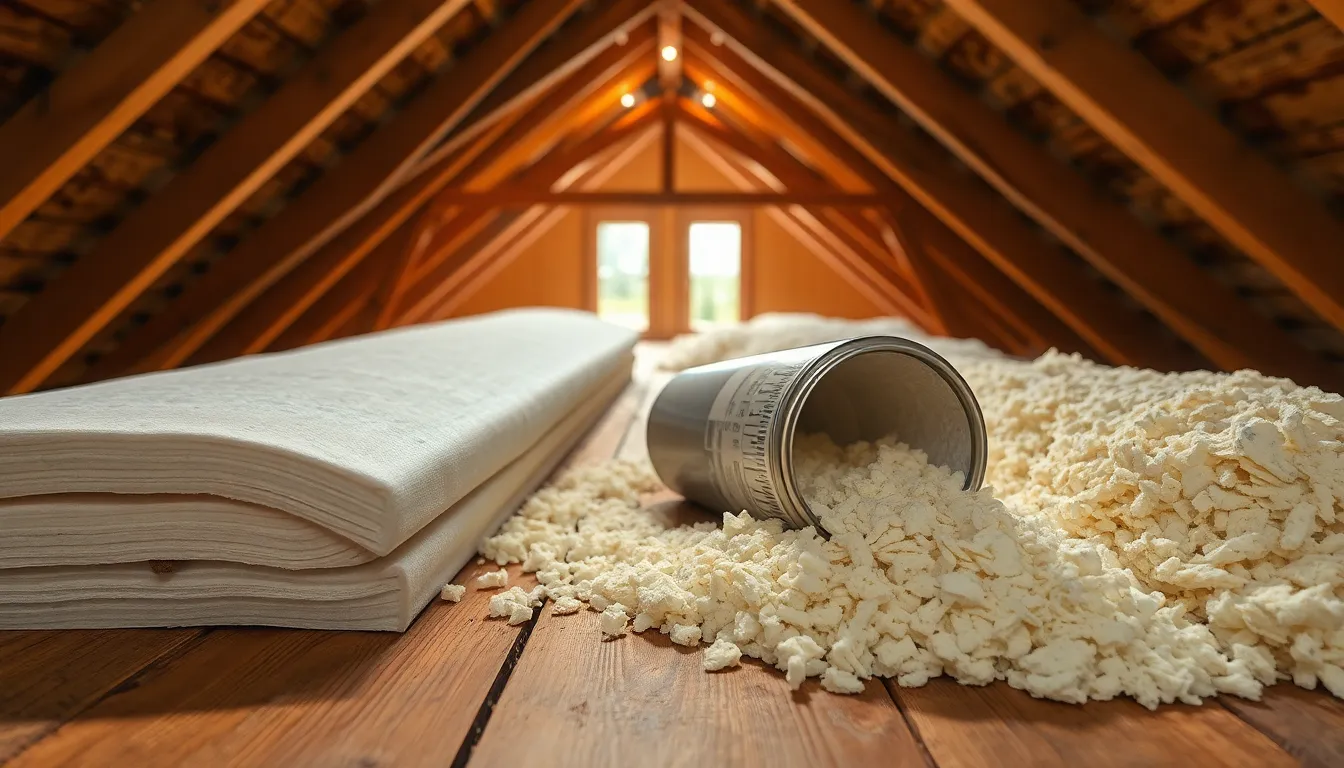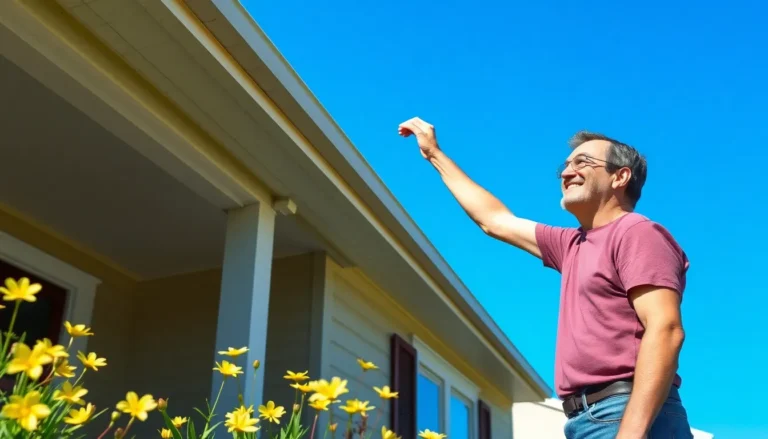Ever wondered why your attic feels like a sauna in summer and a freezer in winter? It’s not just the ghost of your last DIY project haunting you; it’s a lack of proper insulation! Insulating your attic isn’t just a home improvement project; it’s a ticket to comfort and savings. Imagine cozy winters where you don’t need to wear three sweaters indoors, or summers where your air conditioner doesn’t have to work overtime.
Not only does attic insulation keep your home cozy, but it also helps save on energy bills. Who wouldn’t want to keep those extra dollars in their pocket? So, let’s dive into the world of attic insulation and discover how this simple upgrade can transform your living space from a temperature rollercoaster into a haven of comfort.
Table of Contents
ToggleImportance Of Attic Insulation
Attic insulation plays a crucial role in maintaining home comfort. Proper insulation limits heat transfer, preventing unwanted temperature swings. During summer, well-insulated attics keep homes cooler by resisting heat gain. In winter, they help retain heat, ensuring warmth throughout living spaces.
Energy efficiency increases with effective attic insulation. Homes with inadequate insulation can see energy bills rise by up to 30%. Lowering those costs becomes possible with enhanced insulation. It allows HVAC systems to operate more efficiently, reducing unnecessary wear and tear.
Health benefits arise from improved attic insulation. Reducing temperature fluctuations minimizes mold growth and enhances indoor air quality. The overall environment becomes healthier, contributing to better well-being. Homeowners enjoy peace of mind knowing their home maintains stable temperatures.
Environmental impact also comes into play. Increased energy efficiency translates to reduced carbon footprints. By insulating attics, homeowners contribute to a more sustainable future.
Likewise, home resale value can increase with proper attic insulation. Potential buyers appreciate energy-efficient features when evaluating properties. A well-insulated attic signifies a home that’s ready for energy-efficient living.
Building codes often emphasize the importance of attic insulation. Many local regulations require specific insulation types and R-values to ensure comfort and safety. When upgrading insulation, homeowners follow these guidelines to remain compliant.
In short, attic insulation significantly enhances comfort, energy efficiency, health, environmental sustainability, resale value, and compliance with regulations.
Types Of Attic Insulation

Attic insulation comes in various types, each with unique characteristics that suit specific needs and preferences. Homeowners often choose among fiberglass, spray foam, and cellulose insulation.
Fiberglass Insulation
Fiberglass insulation utilizes fine glass fibers to trap air, effectively resisting heat transfer. It’s lightweight, making it easy to install in attics. R-values typically range between 11 and 38, depending on thickness. This option is non-combustible and does not absorb moisture, which helps prevent mold growth. Many homeowners appreciate its affordability, with costs averaging around $0.60 to $1.20 per square foot. Additionally, fiberglass is often available in pre-cut batts or loose-fill forms, allowing for versatile installation options.
Spray Foam Insulation
Spray foam insulation expands on application, filling gaps and cracks in attics. Its high R-values ranging from 6 to 7 per inch make it a superior insulator, minimizing air leakage. Homeowners find it beneficial for sealing irregularly shaped areas, creating a continuous barrier against moisture. Due to its strong adhesion properties, spray foam offers long-lasting performance. Installation costs usually fall between $1.50 and $3.00 per square foot, reflecting its effective energy-saving capabilities. Additionally, it contributes to a quieter attic environment by dampening sound.
Cellulose Insulation
Cellulose insulation consists primarily of recycled paper products, making it an environmentally friendly option. This type often exhibits R-values from 13 to 15 per inch, showcasing its respectable thermal performance. Homeowners appreciate its ability to reduce air infiltration, contributing to improved energy efficiency. The installation process commonly involves blowing the insulation into the attic, ensuring thorough coverage. Cost-wise, cellulose typically ranges from $0.80 to $2.00 per square foot, allowing for its widespread use. Its natural ability to resist pests and mold adds to its appeal for environmentally conscious consumers.
Benefits Of Insulating Your Attic
Insulating an attic offers several key advantages for homeowners that go beyond energy savings. Significant benefits include energy efficiency, improved comfort, and noise reduction.
Energy Efficiency
Attic insulation enhances energy efficiency by minimizing heat loss in winter and heat gain in summer. A well-insulated attic can reduce energy bills by up to 30%. Proper insulation prevents drafts and maintains a consistent temperature throughout the home. Selecting the right R-value meets building code requirements while maximizing energy savings. Investing in insulation pays off in the long run, often leading to lower monthly utility costs.
Improved Comfort
Comfort levels within a home increase with effective attic insulation. Homeowners experience fewer temperature fluctuations, creating a more pleasant living environment throughout the year. Insulation ensures that rooms remain warm in winter and cool in summer, contributing to an overall improved indoor climate. This stability aids in reducing the reliance on heating and cooling systems, leading to additional comfort and efficiency. Enhanced comfort significantly impacts occupants’ enjoyment of their living space.
Noise Reduction
Noise reduction represents another benefit of attic insulation. Insulation helps dampen sound transmission between rooms, creating a quieter home environment. It significantly lessens outdoor noise infiltration, making homes more peaceful. Homeowners appreciate the added tranquility, especially in busy or noisy neighborhoods. Effective insulation material also absorbs sound, acting as a barrier against unwanted disturbances. This feature enhances the overall quality of life within the home.
How To Insulate Your Attic
Proper attic insulation enhances comfort and energy efficiency. Homeowners can choose between several methods depending on their preferences and skill levels.
DIY Insulation Process
Inspect the attic for existing insulation and assess its condition. Clear out any debris and repair leaks before starting. Choosing the right insulation material is essential; options include fiberglass batts, cellulose, or spray foam. Measure the attic space to determine the required amount of insulation. When installing batts, lay them perpendicular to existing insulation for better coverage. Ensure a snug fit to minimize air gaps. For spray foam, use a foam kit that expands upon application to fill cracks and crevices. After installation, monitor air quality and temperature stability to ensure effective insulation.
When To Hire Professionals
Hiring professionals may become necessary for certain situations. If the attic has complex shapes, extensive air leaks, or requires significant remediation efforts, experts can provide valuable assistance. Insulating beyond typical R-values often requires specialized knowledge. Homeowners might face health risks related to asbestos when dealing with older insulation materials, prompting the need for licensed contractors. Local building codes may specify rules governing insulation installation; professionals ensure compliance with these regulations. When uncertain about insulation types or installation methods, seeking professional advice can prevent costly mistakes. Homeowners prioritize safe, effective insulation, recognizing the potential for long-term savings and comfort.
Common Mistakes To Avoid
Homeowners often overlook air leaks when insulating their attics. Sealing gaps around ducts, vents, and electrical lines prevents conditioned air from escaping and enhances insulation effectiveness.
Inadequate insulation depth poses another common issue. Achieving the recommended R-value, which varies by climate, ensures optimal thermal resistance and energy efficiency. Properly measuring insulation material can prevent underinsulation.
Using the wrong insulation type is a frequent mistake. Each material has distinct properties, and selecting the right insulation based on specific needs is essential. For instance, fiberglass offers affordability, while spray foam provides superior sealing capabilities.
Neglecting moisture control can lead to significant problems. Installing a vapor barrier reduces the chances of moisture build-up, which can cause mold growth and damage insulation.
Failing to consider attic ventilation is a misstep many make. Adequate ventilation prevents overheating, especially in warmer months, and protects insulation integrity.
Skipping professional inspection can also be a costly error. Engaging experts ensures compliance with building codes and proper installation techniques.
Not utilizing proper safety equipment during installation can pose health risks. Wearing masks, gloves, and goggles helps mitigate exposure to irritants.
Lastly, ignoring local building codes can lead to fines and future complications. Familiarizing oneself with regulations related to insulation types and installation practices is crucial for long-term benefits.
Investing in attic insulation is a smart move for any homeowner looking to enhance comfort and efficiency. Proper insulation not only stabilizes indoor temperatures but also significantly reduces energy bills and promotes a healthier living environment. By choosing the right type of insulation and ensuring proper installation, homeowners can enjoy long-term benefits that extend beyond just savings.
Moreover, improved attic insulation contributes to environmental sustainability while potentially increasing property value. With the right approach and awareness of common pitfalls, anyone can create a more energy-efficient home. Prioritizing attic insulation is a step towards a more comfortable and eco-friendly lifestyle.



